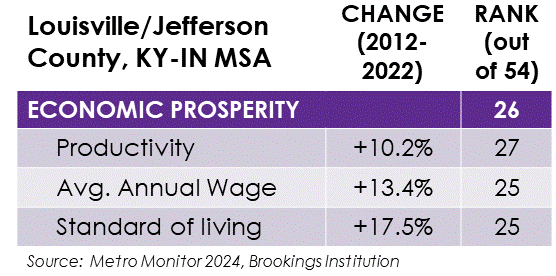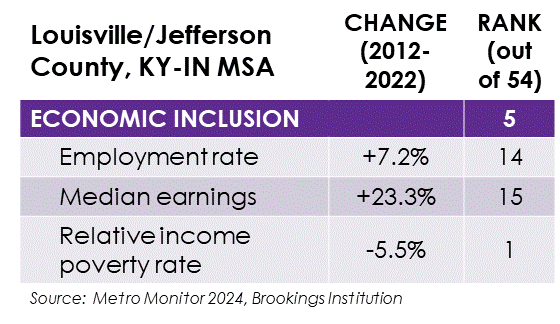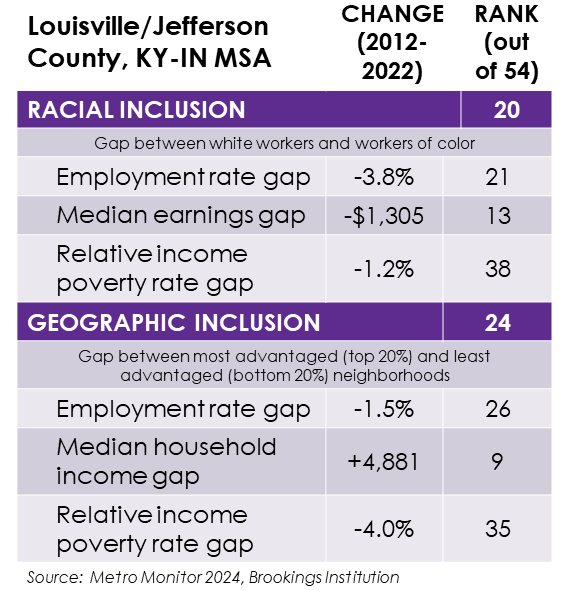Economic performance over the last decade, an update from Metro Monitor
The Brookings Institution recently released the 2024 Metro Monitor, an easy-to-use tool to look at how regional economies have been performing over the last decade in five broad categories.
The nation’s economic growth has been strongest in very large metropolitan areas with more than one million people. The Louisville/Jefferson County, KY-IN Metropolitan Statistical Area is one of 54 very large metro areas across the country.
Overall, the Louisville region’s performance was modest, ranking primarily in the middle of the 54 largest metro areas on measures of growth, prosperity, racial inclusion, and geographic inclusion. The region did score relatively high, 5th among metro areas, on measures of overall inclusion.
On measures of economic growth, the Louisville region ranked 29th among the 54 largest metro areas. Growth in jobs and gross metropolitan product outpaced the nation, but generally lagged behind the average for all large metros. Louisville scored 34th in job growth at young firms, signaling weaker entrepreneurial growth as compared to other large metro areas.
Prosperity gains over the last decade have been concentrated in the nation’s west, in metro areas with significant tech and startup sectors. The Louisville region ranked 26th among the 54 largest metro areas, indicating that relative prosperity grew slightly faster than relative economic growth. The region’s annual average wage grew 13% over the decade, and productivity was up 10%.
The Louisville region ranked 5th among large metro areas on measures of economic inclusion, signaling that economic gains have been felt across the entire population. Growth in overall employment and median earnings (adjusted for inflation and regional cost-of-living) outpaced the nation, and ranked in the top third of large metro areas. The region saw the largest decline in the relative income poverty rate among large metro areas, which measures the share of workers earning less than half of the local median wage. This indicates that workers at the very bottom of the income distribution have realized meaningful earnings gains.
Unfortunately, these positive outcomes on measures of inclusion were not well distributed among racial groups and neighborhoods. The Louisville region ranked 20th among large metro areas in measures of racial inclusion and 24th in measures of geographic inclusion. In particular, the significant decline in the relative income poverty rate was driven primarily by white workers. When accounting for racial disparities in this measure, the region’s ranking falls to 38th. The pattern holds when comparing geographic disparities, where the region ranked 35th in the change in the relative income poverty rate among the region’s most advantaged and disadvantaged neighborhoods.
The region did make some progress on shrinking the gap in racial disparities. The employment rate gap between white workers and workers of color fell by 4% over the decade. The gap in median earnings between white workers and workers of color also declined, falling by $1,305 over the same period. However, this progress was not equitable across neighborhoods. The gap in employment rates between the most and least advantaged neighborhoods only shrank by 1.5%. The gap in median household income between the most and least advantaged neighborhoods increased by nearly $5,000. Geographic segregation is even more problematic in the nation’s largest metros, so even though the problem has gotten worse, the region ranked 9th among large metros.
So, even though some progress has been made, white workers are still working and earning more than workers of color. In particular, the most disadvantaged neighborhoods, which also have high concentrations of workers of color, are not experiencing the same progress.
Over the last decade, the Louisville region has enjoyed a relatively good economy. The region generally outperformed the nation on measures of economic activity. However, Louisville’s performance was mediocre when compared to other very large metropolitan areas. Neighboring metros including Indianapolis and Cincinnati also generally scored in the middle of the performance rankings for large metro areas, while Nashville ranked among the top 10 metros in 3 of the 5 performance indicators.
To explore more data on economic performance between 2012 and 2022, check out the Brookings Institution Metro Monitor 2024.




